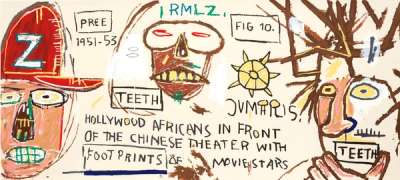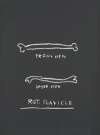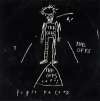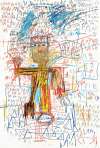Hollywood
Africans
Jean-Michel Basquiat’s Hollywood Africans deconstructs stereotypes of Blackness in Hollywood. As well as drawing attention to Hollywood’s racist and reductive typecasting, Basquiat makes allusions to real Black stars who, eager to make their name, have historically been forced to make themselves complicit in their stereotyping.
Jean-Michel Basquiat Hollywood Africans For sale
Hollywood Africans Value (5 Years)
Sales data across the Hollywood Africans series by Jean-Michel Basquiat varies by print. While standout works have sold at auction for up to £132874, other editions in the series remain rare to market or have yet to appear publicly for sale. Of those tracked, average selling prices have ranged from £52268 to £63799, with an annual growth rate of 2.83% across available data. Collectors should note the discrepancy in performance between more visible and lesser-seen editions when considering value potential in this series.
Hollywood Africans Market value
Auction Results
| Artwork | Auction Date | Auction House | Return to Seller | Hammer Price | Buyer Paid |
|---|---|---|---|---|---|
Hollywood Africans In Front Of The Chinese Theatre With Footprints Of Movie Stars Jean-Michel Basquiat Unsigned Print | 16 Apr 2024 | Christie's New York | £42,500 | £50,000 | £70,000 |
Sell Your Art
with Us
with Us
Join Our Network of Collectors. Buy, Sell and Track Demand
Meaning & Analysis
In Hollywood Africans In Front Of The Chinese Theatre With Footprints Of Movie Stars, Basquiat alludes to and deconstructs stereotypes of Blackness in the world of Hollywood entertainment. This print depicts Basquiat and two close friends of the artists, Toxic and Ramellzee. Together, the trio referred to themselves as the Hollywood Africans.
One of the faces has his mouth completely covered by text, while the other two are drawn with exaggeratedly large mouths, teeth clenched. The image suggests Black stars lacking agency and an authentic voice in America’s cultural landscape. The crossing out of text underlines the theme of exclusion. Paradoxically, the obfuscation of text suggests excision whilst drawing attention to the words beneath. Basquiat famously remarked: “I cross out words so you will see them more: the fact that they are obscured makes you want to read them.”
The emphasis on stereotypes of Blackness draws attention to the limiting depiction of Black artists in American entertainment. As Laurie A Rodriguez notes, “the artist reveals for us the machinery at work behind the construction of the celebrity black American figure - a commodified Africanist presence, distilled and packaged for consumption by the mainstream masses”.
Both in title and subject, this print recalls the artist’s 1983 painting Hollywood Africans. In this piece, three faces are surrounded by notations including “What is Bwana?”, “Tobacco,” “Gangsterism,” which alludes to the stereotypical characterisation of Black figures in Hollywood cinema, set against a backdrop of yellow, black and blue which gestures to the popularised imagination of Los Angeles as an evocative blend of urban space, sun and the rich blue of the Pacific ocean.
Hollywood Africans draws attention to how Black representation in cinema has been limited to reductive stereotypes. The depiction of himself alongside contemporaries and hip-hop artists Toxic and Rammellzee (whose single “Beat-Bop” was produced by Basquiat) , positions themselves as subject to the same limiting palette from which images of black celebrity have historically been drawn in the American imagination. The statuette and date 1940 next to it could be interpreted to allude to Hattie McDaniel becoming the first Black performer to win an Academy Award for her role Gone with the Wind; a performance which was contentious with the actor facing accusations of being complicit in the perpetuation of racist stereotypes.











